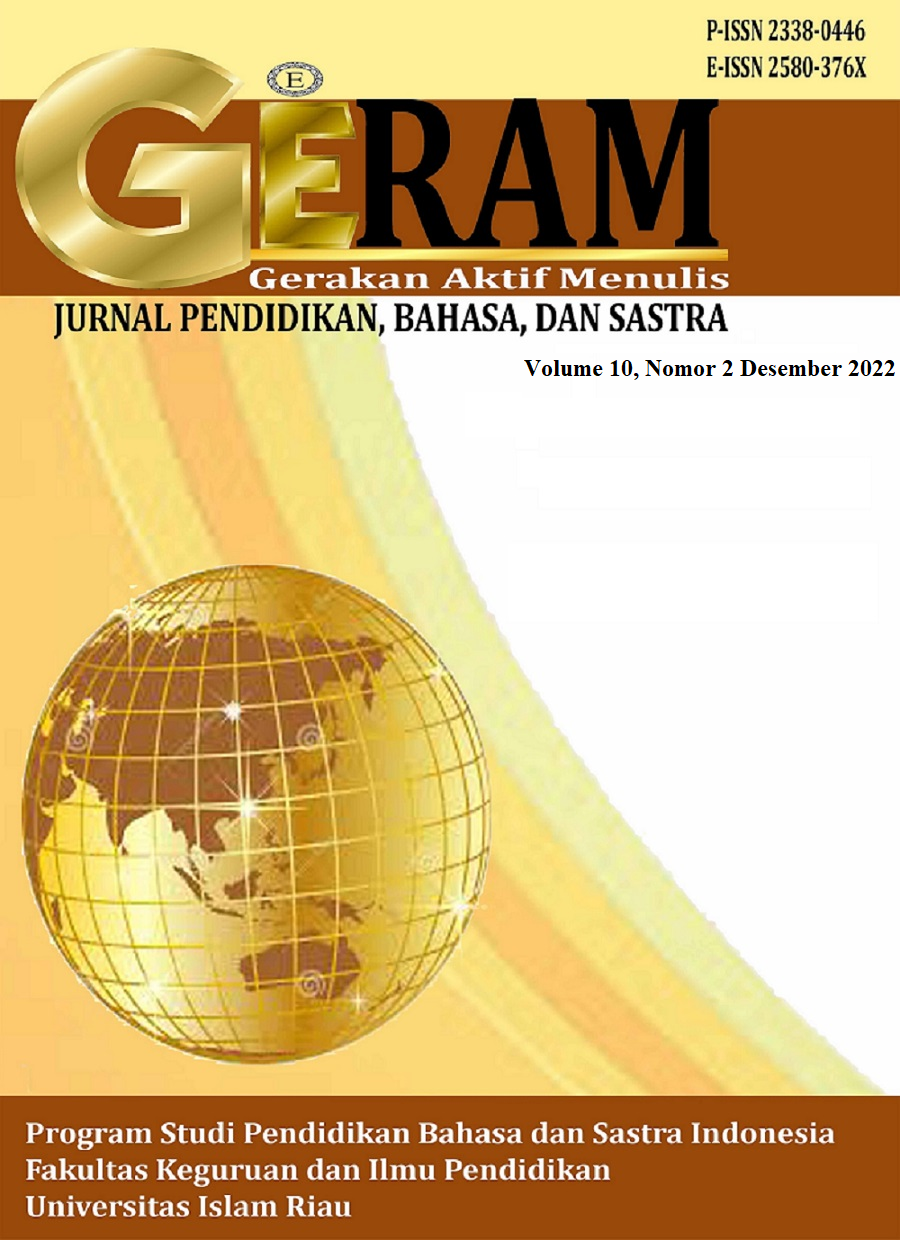Deiksis Persona Dalam Novel Muara Rasa Karya Devania Annesya dan Pemanfaatannya sebagai Bahan Ajar Bahasa Indonesia Tingkat SMP Kelas IX
Keywords:
teaching materials, persona deixis, Muara Rasa NovelAbstract
Communicating activities in everyday life must pay attention to aspects such as the interlocutor, the context of the conversation, and the place and time of the speaking activity. To make sentences effective and efficient, speakers can use deixis in communicating. Deixis is a word that moves depending on who is speaking and the context of the conversation. The use of deixis can be helpful in direct or verbal and indirect or written communication activities. Examples of indirect communication can be realized in literary works like novels. The researcher chose the novel Muara Rasa as the subject in connection with the research to be conducted. The research objective is to describe the types, forms, and functions of persona deixis used in the Muara Rasa novel by Devania Annesya and the use of persona deixis in the novel “Muara Rasa by Devania Annesya learning Indonesian in junior high school class IX. The data in this study are dialogues containing persona deixis in the novel Muara Rasa by Devania Annesya, which was published in December 2015 with 186 pages. The data analysis technique used in this research is the matching method. Based on the research that researchers have done in the novel Muara Rasa. Three types of personal deixis are used in the novel Muara Rasa: the first-person deixis, the second-person deixis, and the third-person deixis. Judging from its shape, the form of persona deixis found in the novel Muara Rasa, is the first single form of persona deixis, namely the form of me, with 244 uses. The form of the first persona deixis is plural, i.e., our form has 40 usages, and ours has 13 usages. The form of the second persona deixis is singular, the form of you as many as 179 uses. The second form of persona deixis is plural; your form has 27 uses. The form of third person singular deixis is the form of dia as many as 57
Downloads
References
Chaer, (2006). Tata Bahasa Praktis Bahasa Indonesia. Jakarta: Rineka Cipta.
Fahrunisa, Nida, Asep Purwo Yudi Utomo. (2020). “Deiksis Persona Dalam Film Dua Garis Biru Karya Gina S, Noer Produksi Stravision Dan Wahana Kreator”. Semiotika, 21(2), hlm. 103-113.
Ismawati, E. (2012). Metode Penelitian Pendidikan Bahasa dan Sastra. Surakarta: Ombak.
Ismawati, E. (2012). Telaah Kurikulum dan Pengembangan Bahan Ajar. Yogyakarta: Ombak.
Nurgiantoro, B. (2015). Teori Pengkajian Fiksi. Bandung: Gadjah Mada University Press.
Purwo, B. K. (1984). Deiksis dalam Bahasa Indonesia. Jakarta: PN Balai Pustaka.
Putrayasa, I. B. (2015). Pragmatik. Yogyakarta: Graha Ilmu.
Ramdhan, M. (2021). Metode Penelitian. Surabaya: Cipta Media Nusantara.
Sudaryat, Y. (2006). Makna dalam Wacana. Bandung: Yrama Widya.
Sudaryanto. (2015). Metode dan Aneka Teknik Analisis Bahasa. Yogyakarta: Sanata Dharma.
Suhadi. (2001). Memenangkan Lomba Mengarang. Jakarta : Balai Pustaka.
Sulistyowati, H. (2012). Mengenal Struktur Atribut Frasa. Malang : Madani.
Widodo. (2019). Metodologi Penelitian Populer&Praktis. Depok: Rajawali Pers.
Yanti, U. N., Syafrial, dan Charlina, (2018). “Moral Value In Novel Megat By Rida K Liamsi”, dalam JOM FKIP, 5(2), hlm. 1-8.
Yule, G. (2018). Pragmatik. Yogyakarta: Pustaka Pelajar.

















